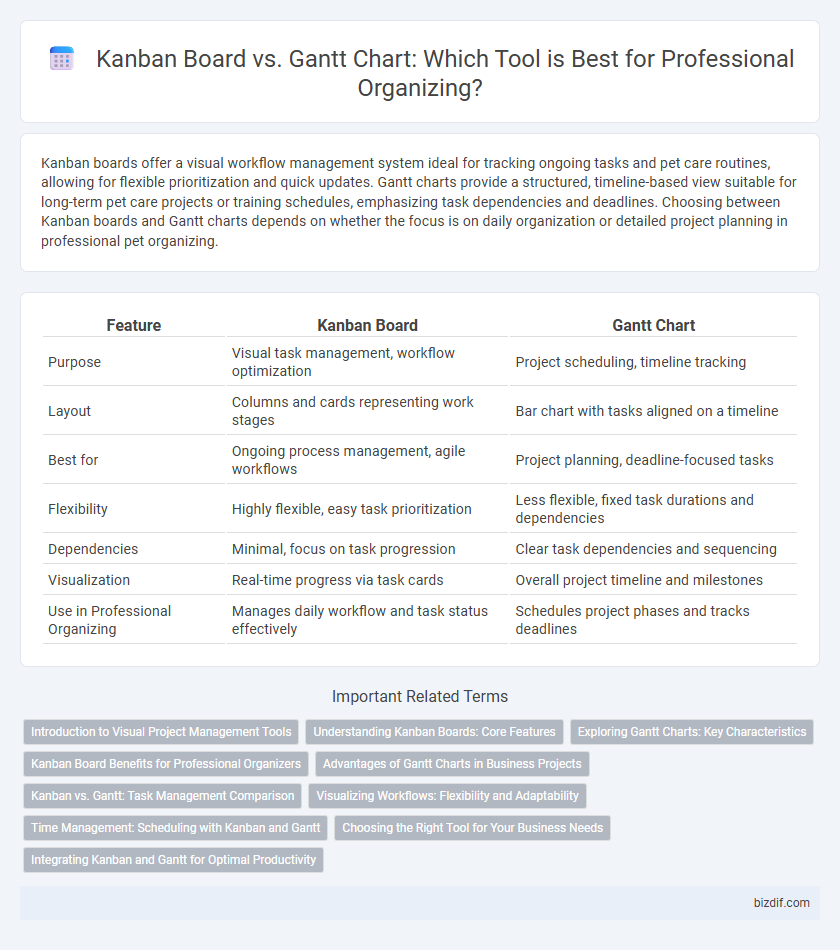Kanban boards offer a visual workflow management system ideal for tracking ongoing tasks and pet care routines, allowing for flexible prioritization and quick updates. Gantt charts provide a structured, timeline-based view suitable for long-term pet care projects or training schedules, emphasizing task dependencies and deadlines. Choosing between Kanban boards and Gantt charts depends on whether the focus is on daily organization or detailed project planning in professional pet organizing.
Table of Comparison
| Feature | Kanban Board | Gantt Chart |
|---|---|---|
| Purpose | Visual task management, workflow optimization | Project scheduling, timeline tracking |
| Layout | Columns and cards representing work stages | Bar chart with tasks aligned on a timeline |
| Best for | Ongoing process management, agile workflows | Project planning, deadline-focused tasks |
| Flexibility | Highly flexible, easy task prioritization | Less flexible, fixed task durations and dependencies |
| Dependencies | Minimal, focus on task progression | Clear task dependencies and sequencing |
| Visualization | Real-time progress via task cards | Overall project timeline and milestones |
| Use in Professional Organizing | Manages daily workflow and task status effectively | Schedules project phases and tracks deadlines |
Introduction to Visual Project Management Tools
Kanban boards and Gantt charts are essential visual project management tools used to enhance workflow efficiency and task tracking in professional organizing. Kanban boards utilize columns and cards to represent tasks and their progress, promoting adaptability and real-time updates. Gantt charts provide a chronological timeline view of project activities, emphasizing dependencies and deadlines for effective long-term planning.
Understanding Kanban Boards: Core Features
Kanban boards visualize workflow through columns representing process stages, enabling real-time task tracking and limit setting for work in progress. Their core features include customizable task cards, clear status indicators, and swimlanes for task categorization, enhancing transparency and team collaboration. Unlike Gantt charts, Kanban boards emphasize continuous flow and flexibility, making them ideal for dynamic project environments and iterative work cycles.
Exploring Gantt Charts: Key Characteristics
Gantt charts visualize project timelines by displaying tasks as horizontal bars along a calendar, highlighting start and end dates for each activity. They effectively track dependencies and progress, making it easier to coordinate complex schedules in professional organizing projects. Detailed timeframes and milestones provide clarity for resource allocation and deadline management.
Kanban Board Benefits for Professional Organizers
Kanban boards enhance workflow visualization by allowing professional organizers to track tasks in real-time, promoting flexibility and quick adjustments to changing priorities. The board's intuitive columns and cards system streamlines task management and improves team collaboration, reducing project bottlenecks. With its emphasis on continuous delivery and workload balance, Kanban supports efficient time management and boosts overall productivity in organizing projects.
Advantages of Gantt Charts in Business Projects
Gantt charts provide a clear timeline visualization that helps teams track project milestones and deadlines effectively. They enhance resource allocation by displaying task dependencies and durations, reducing risks of bottlenecks in complex business projects. Businesses benefit from improved coordination and progress monitoring through the structured layout of Gantt charts.
Kanban vs. Gantt: Task Management Comparison
Kanban boards offer a visual workflow management system that emphasizes task status and continuous progress, ideal for flexible project environments. Gantt charts provide a timeline-based overview, highlighting task dependencies and deadlines, which suits projects with fixed schedules and sequential steps. Comparing Kanban vs. Gantt for task management reveals Kanban's strength in adaptability and team collaboration, while Gantt excels in structured planning and deadline tracking.
Visualizing Workflows: Flexibility and Adaptability
Kanban boards excel in visualizing workflows by offering a flexible, real-time overview of tasks through cards and columns, allowing teams to easily adapt to changing priorities and workloads. Gantt charts provide a structured, timeline-based visualization ideal for tracking project progress and dependencies, but they are less adaptable to sudden alterations. Professional organizers often prefer Kanban boards for dynamic environments requiring continuous adjustments, while Gantt charts suit projects with fixed schedules and clearly defined milestones.
Time Management: Scheduling with Kanban and Gantt
Kanban boards excel in visualizing workflows and managing tasks in real-time, allowing flexible scheduling and prioritization based on current progress. Gantt charts provide a detailed timeline view, highlighting task dependencies and deadlines to ensure precise project milestones and resource allocation. Combining Kanban's adaptability with Gantt's structured scheduling enhances overall time management efficiency in professional organizing.
Choosing the Right Tool for Your Business Needs
Kanban boards excel in visualizing workflow and managing tasks in real-time, making them ideal for businesses requiring flexibility and continuous progress tracking. Gantt charts provide a comprehensive timeline view, perfect for projects with fixed deadlines and dependent tasks, ensuring effective scheduling and resource allocation. Choosing the right tool depends on your business needs: Kanban supports dynamic task management while Gantt charts facilitate detailed project planning and deadline adherence.
Integrating Kanban and Gantt for Optimal Productivity
Integrating Kanban boards with Gantt charts enhances project management by combining visual task flow with timeline tracking, ensuring clear deadlines and process efficiency. Kanban boards provide real-time work-in-progress visualization, while Gantt charts offer structured scheduling and milestone monitoring. This dual approach optimizes productivity by enabling dynamic task prioritization alongside strategic timeline management.
Kanban board vs Gantt chart Infographic

 bizdif.com
bizdif.com